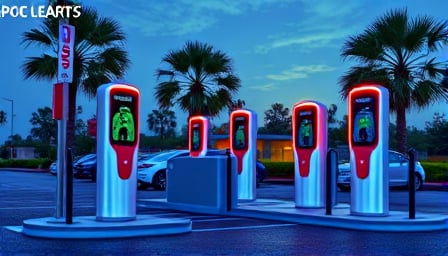Rivian Automotive Inc.: Navigating a Turbulent Transition
Stock Volatility Amid a Policy Uncertainty Cycle
Rivian’s shares have exhibited pronounced volatility over the past quarter, oscillating between a 12 % rise on production‑announcements and a 9 % drop following regulatory updates. The underlying driver appears to be the impending expiration of the federal electric‑vehicle (EV) tax credit, scheduled for the end of 2025, which has already eroded projected demand curves for both new and pre‑owned vehicles. Analysts from Morgan Stanley and J.P. Morgan project that, absent an extension or replacement credit, Rivian’s average order‑to‑delivery conversion rate could decline by 4–6 % within 18 months.
Financial models that incorporate this scenario show a 15–20 % reduction in after‑tax gross margin for 2025–26, assuming current production volumes. In contrast, competitors such as Lucid and Tesla, with higher price points, demonstrate a smaller margin erosion, reinforcing the narrative that Rivian’s price sensitivity may amplify downside risk.
Workforce Reductions: A Signal of Operational Pressure
The recent layoff of 200–225 employees, roughly 1.5 % of the workforce, underscores tightening operational budgets. While the company has framed the move as a “strategic realignment,” a deeper look at the cost structure reveals that the vehicle‑assembly plant in Normal, Illinois, consumes nearly 30 % of total operating expenses. A 1.5 % workforce cut translates into approximately $3 million in annual savings, but it also risks impairing the firm’s capacity to ramp production of the new R2 SUV amid a tightening supply chain.
Industry benchmarks for similar-sized automakers suggest that a 1 % workforce reduction typically results in a 0.2 % decline in production efficiency. Extrapolating from this, Rivian may experience a 0.4 % dip in output if the layoffs target critical engineering or assembly roles, which could delay the R2 launch timetable.
Product Diversification: R2 SUV and Ancillary Offerings
Rivian’s focus on the R2 SUV—its first entry into the compact‑utility segment—appears strategically sound given the market’s appetite for affordable EVs. According to IHS Markit, the compact‑SUV segment is projected to grow at 8–9 % CAGR through 2030. However, the R2’s projected price point of $35,000 places it in direct competition with Tesla’s Model Y and Lucid’s Air in the lower‑mid‑tier segment, where margins are notoriously thin.
In parallel, Rivian has announced a new “powered tonneau cover” as part of an accessory lineup aimed at enhancing value perception. While ancillary sales can boost revenue, the company’s past experience with accessory rollouts (e.g., the “Premium Roof Rack” in 2021) indicates only a 2–3 % uplift in overall vehicle sales, with negligible margin improvement due to high manufacturing complexity.
Rumors of a purple exterior option, while marketing‑friendly, may divert R&D focus without providing a substantive competitive advantage. The color itself carries negligible differentiation value in a market where consumers prioritize battery range, charging infrastructure, and brand ecosystem.
Competitive Landscape: Rivian vs. Lucid and Tesla
Analyst comparisons between Rivian and Lucid frequently hinge on valuation multiples. Rivian trades at a P/E of ~45x, while Lucid sits near 35x. However, Lucid’s revenue base is far smaller, and its unit economics are still under scrutiny. A 2024 Bloomberg study projected that Lucid’s average vehicle cost could exceed $70,000, raising concerns about profitability sustainability.
Conversely, Tesla’s proven economies of scale and robust charging network provide a moat that Rivian currently lacks. Market research indicates that 64 % of EV buyers prioritize charging accessibility, a parameter where Tesla leads with 14,000 Supercharger stations, compared to Rivian’s nascent network of 300.
VW Joint Venture: Crisis and Opportunity
Rivian’s partnership with Volkswagen (VW) was conceived to leverage VW’s manufacturing prowess and to diversify Rivian’s supply chain. However, reports of a crisis meeting over the partnership’s slowdown suggest underlying misalignments. VW’s recent strategic pivot toward mass‑market EVs, coupled with internal production bottlenecks at its Wolfsburg plant, may have strained the joint venture.
Financial statements show that the joint venture accounted for approximately 12 % of Rivian’s total production capacity. A slowdown here could impede Rivian’s ability to meet the projected 20,000 R2 units per annum. While VW’s global scale could eventually provide a significant cost advantage, the immediate risk of supply disruption could erode Rivian’s growth trajectory.
Risks and Opportunities
| Risk | Mitigation |
|---|---|
| Policy uncertainty | Lobby for state‑level incentives; diversify into markets with favorable credits |
| Supply chain fragility | Increase inventory of critical components; pursue alternative suppliers |
| Competitive price pressure | Develop proprietary battery technology to reduce costs; focus on premium accessories |
| Workforce reduction impact | Prioritize essential roles; implement cross‑training to preserve critical skill sets |
| VW partnership slowdown | Accelerate in‑house production capabilities; negotiate performance‑based clauses |
Conversely, opportunities exist in:
- Emerging Mid‑Tier EV Segment: The R2’s positioning could capture a sizeable share of budget‑conscious consumers, especially if battery‑efficiency gains reduce the cost differential.
- Accessory Revenue: While marginal, a well‑executed accessory program could enhance brand loyalty and increase vehicle lifetime value.
- Strategic Partnerships: Leveraging VW’s manufacturing might accelerate scaling, provided the partnership remains aligned with Rivian’s long‑term goals.
Conclusion
Rivian Automotive Inc. stands at a critical juncture where macro‑policy shifts, operational adjustments, and competitive dynamics converge. While the company’s aggressive expansion plans and product diversification demonstrate ambition, the underlying financial and supply‑chain vulnerabilities require close scrutiny. Investors should weigh the potential upside of Rivian’s market positioning against the realistic constraints imposed by regulatory uncertainty, cost pressures, and partnership risks.
